
Attendant Soundscapes of Phenomenological Installations
By MALTE WAGENFELD
- View Malte Wagenfeld's Biography
Malte Wagenfeld is a designer, curator, researcher, installation artist and academic; he is currently Senior Lecturer of Industrial Design at RMIT University in Melbourne, Australia.
Attendant Soundscapes of Phenomenological Installations
By MALTE WAGENFELD
1. - Introduction
In 1991, John Cage sat near a partially open window in his apartment on the corner of West 18th Street and Sixth Avenue listening to Manhattan traffic. "I love the activity of sound," he declares; such sounds are not "talking to us or trying to be anything, they just are."1
Cage's attunement to the beauty of sounds just as they are is elemental to my design research practice, Aesthetics of Air, which explores our sensory and metaphysical engagement with air, and how designing with atmospheric phenomena to create experientially rich atmospheres for living and working constitutes a new design practice.
My reading of the 'aesthetics' of air is framed in the context of Gernot Böhme's statement:
Aesthetics of atmosphere shifts attention from the 'what' something represents, to the 'how' something is present. In this way, sensory perception as opposed to judgment is rehabilitated in aesthetics and the term 'aesthetic' is restored to its original meaning, namely the theory of perception.2
My practice is principally phenomenological, not so much in a psychological or philosophical sense - although drawing from these - but practice-based, through the study of phenomena and then devising ways of designing 'with' phenomena to create atmospheric environments. I consider phenomena to be spatiotemporal events creating an affective force that acts on things and on us, as energy such as heat or light or forces such as breezes and soundwaves.
My approach is to study phenomena at first hand and then devise ways of designing 'with' them. Staging aesthetic atmospheres3 is an act of wrangling and working with phenomena and requires a grounded understanding of the deep phenomenological and perceptual interconnectedness of air and sound, atmosphere and soundscape.
Air is both my material and medium. As material, air surrounds us, we breathe it as a life force and through it we experience the world. As a medium, we feel air in breezes, moisture and temperature. We can smell and taste molecules carried by air, and hear sounds traveling through it, which are shaped and bent by it. As Jean-Paul Thibaud explains, "the medium is not what we perceive, not the object of our perception. The medium is the means by which we perceive, it is what makes perception possible."4 As medium, air is a carrier of phenomena and perceptual effect. Combined, these phenomena and associated perceptual (or aesthetic) experiences are what I consider atmosphere.
The distinction between what constitutes an atmosphere and what constitutes an ambiance is often rather vague, these concepts tend to bleed into one another. "From a theoretical point of view the notion of ambiance is not fundamentally different from the notion of atmosphere."5 But Jean-Paul Thibaud also points towards how they diverge. He speaks of 'installing an atmosphere', as a sort of thing or 'quasi thing' (Griffero 2017)6, and of ambiance as "being laden with value [...], putting us in a certain bodily and effective state, and engaging our senses [...], ambiance is indistinctly the feeling of self and of the world."7 This divergence informs my design approach: atmosphere is the realm of perception - that which is perceived - and ambiance is the experience of atmosphere - what it feels like and the meaning it holds for us personally and collectively.
These definitions inform how I reflect on, 'listen' to and analyse eight phenomenological installations to discover their attendant soundscapes; four of which I staged as designer and four in which I was involved as curator.
2. - Phenomenological installations
Exhibitions play an important role as laboratories in my investigations into air as material and medium, to explore ideas and generate dialogue with audience and peers. Until now, I have not explored the sonic ambiance of my work as designer and curator.
Firstly, I will discuss those installations devised to 'discover' and study atmospheric phenomena - including sound - as design potential; secondly, I will discuss those installations in which atmospheres are staged by designing 'with' phenomena.
2.1 - Atmospheric Structure: Malte Wagenfeld
Atmospheric Structure was created for the exhibition Aesthetics of Air, curated by Suzanne Davies. My intention was to make air 'visible', to directly observe and study atmospheric phenomena, air movement and structure; and gain - and share - insights into how to design with air.
Atmospheric Structure made visible the turbulent flow of toroidal vortices (vortex rings). A pneumatic actuator drive with electronic valve and fog machine, micro-controlled and speed-modulated, shot a vortex ring from an acrylic tube every minute. The equipment's geometry and the fine-tuned accelerative force ensured that the fog consistently formed perfect vortices - revealing the otherwise hidden, ethereal world of transient fluid movement as surprisingly structured yet highly sensitive.
Sited in a narrow gallery space, the atmosphere was controlled so as not to impede the vortices' trajectories. The air-conditioning was turned off, a polyester mesh ceiling was installed to dampen ambient air movement and walls were painted black to lower light levels. The apparatus was housed behind the back wall while the air compressor driving the actuator was placed in a separate sound-proofed room. Only the rim of the transparent acrylic tube, 100 mm in diameter, was seen.
Despite these efforts, the vortices' trajectories - how far they travelled and at what speed, how long they pirouetted through space before dissipating, and their size - varied every time. One vortex travelled up left, the next sank right. Sometimes a brilliantly formed vortex lingered, growing Alice-like into a large, elegantly thin ring; at other times stouter vortices propelled themselves energetically. These phenomena are so sensitive that they react to the faintest atmospheric variance.
My aim was to isolate equipment sounds to enhance the visual sensory experience. The potential of ambient sound attending the installation was not considered, but with each vortex fired the tube behaved like a wind instrument, as can be heard in the video below.
Atmospheric Structure. Malte Wagenfeld. 2011. In: Aesthetics of Air. RMIT Gallery, Melbourne. Video: Malte Wagenfeld.
A short raspy hiss was emitted as fog was preloaded into the chamber followed by a longer hiss. Then, as the pneumatic actuator thrust the plunder down the 400-millimetre tube forcing out fog-laden air, a loud boom reverberated into the space, slowly decaying whilst the vortex lingered for 15 seconds in silence. Then a mechanical sliding sound - like a brush across drum skin - completed with a soft pop as the plunger returned and fell silent. Thirty seconds later the next vortex fired. Over the duration of the exhibition, this unexpected ambient orchestration boomed and hissed, like a mechanical dragon more then 14,000 times.
The soundscape's rhythmic repetition built anticipation with each sonic boom signalling the creation of a new vortex. The ephemeral dance of wraithlike fog rings, always recognisable but never alike, created a symbiotic counterpoint to the linear sound environment, which heighten the transient non-linear behaviour of these aerial phenomena.
The geometry of the gallery acted like a reverberation chamber echoing these sounds throughout the adjoining spaces, creating a distinctive soundscape and encompassing ambiance for the larger exhibition.
2.2 - Atmospheric Sensitivity: Malte Wagenfeld
Also exhibited as part of Aesthetics of Air, the premise of Atmospheric Sensitivity was to reveal the extraordinary sensitivity and sensuous capriciousness of atmospheric phenomena. The work employed piezoelectric transducers (housed out of sight) oscillating at ultrasonic frequencies to vibrate water into a dense cold fog. A cloud of this fog floated upon a long shelf mounted at waist-height.
People were encouraged to interact with the fog-blowing, waving, walking past - to see how intangible air currents effected the fog's form. The fog responded to the faintest indeterminable stimuli.
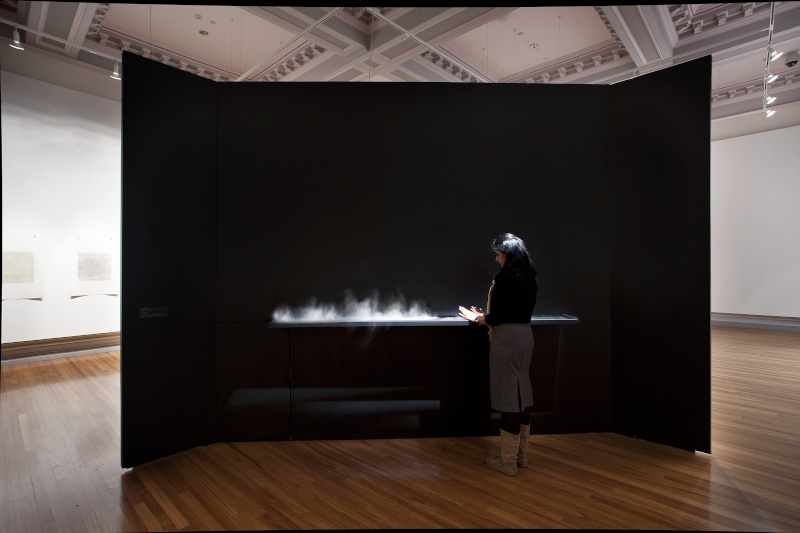
Atmospheric Sensitivity. Malte Wagenfeld. 2011. In: Aesthetics of Air. RMIT Gallery, Melbourne. Photo: Mark Ashkanasy.
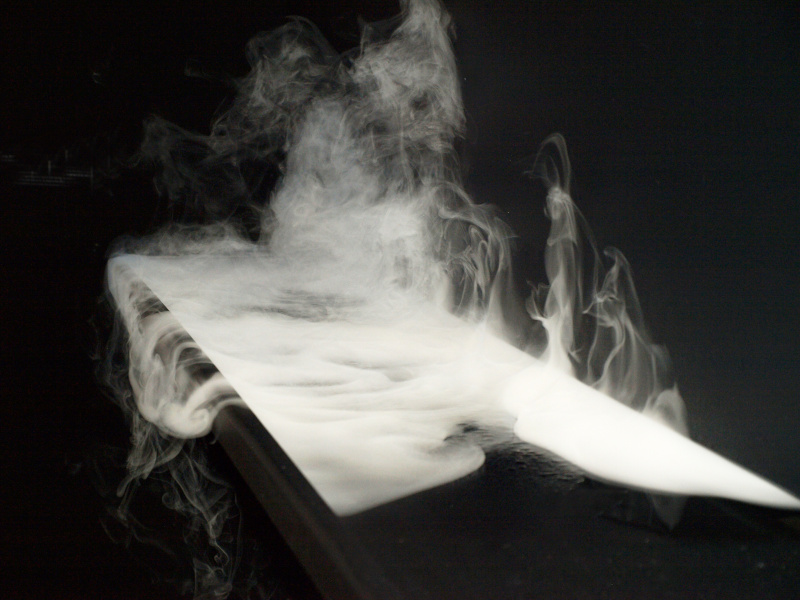
Atmospheric Sensitivity: detail. Malte Wagenfeld. 2011. In: Aesthetics of Air. RMIT Gallery, Melbourne Photo: Malte Wagenfeld.
Apart from an almost imperceptible burble, this installation was silent. Yet, observing the fog morphing into whimsical forms over extended time, with the rest of the gallery blocked from view by the installation, I became highly attuned to the 'silence' manifesting into an ambient soundscape in which aerial atmospheric antics played, while the act of observing transmuted into an act of listening.
2.3 - Night Window: Malte Wagenfeld
Night Window was staged as part of Cloudy Sensoria, an exhibition I also curated with Cara-Ann Simpson. Inspired by Edward Hopper's painting (1928), Night Window explored the window as a performative and poetic architectural element: the eyes, nose and ears of a building, framed around an imagined phenomenological encounter in which the simple act of opening a window or drawing curtains modulates the porous atmospheric relationship between inside and outside.
Exhibited at Bundoora Homestead, once a family home and horse stud, later an institution for war veterans and now a cultural centre, Night Window was a site-specific interpretation of the homestead when it was the aristocratic home of Lady Smith:
On a Summer's evening in 1899, Ellie (Lady Smith) opened her dressing room window: It had been very warm and now a cool change has arrived accompanied by a gentle rainstorm. The air causes the sheer curtains to delicately billow in the breeze, which lightly perfumes the room with the sweet smell of cut hay and wet grass. Beyond the wide protecting balcony she hears the sound of rain, the occasional squawk of native birds and neighing from one of the many horses.
The work was located in the generously sized one-time dressing room, now a white washed, artificially lit and climate-controlled gallery space with inoperable windows. The installation relied on perceptual tricks, including a scripted soundscape, to simulate the impression of and stir psychosomatic memories of standing in front of an open window; to reimagine Ellie's aesthetic encounter with atmosphere - including breezes, sound and scent - over a century ago, when the windows could still be opened.
I constructed a freestanding section of wall with large casement windows at its centre, modelled to appear as an authentic architectural feature. A shadow line falling behind the artifice, created the illusion of the window having been physically dislocated from the rest of the room. Lighting was subdued and dark blue translucent film was applied to the windowpanes to intimate that night had fallen. Micro-controlled fans and devices, which generated breezes laden with moist cool scented air to simulate the open-window inside-outside phenomena, were hidden behind sheer curtains.
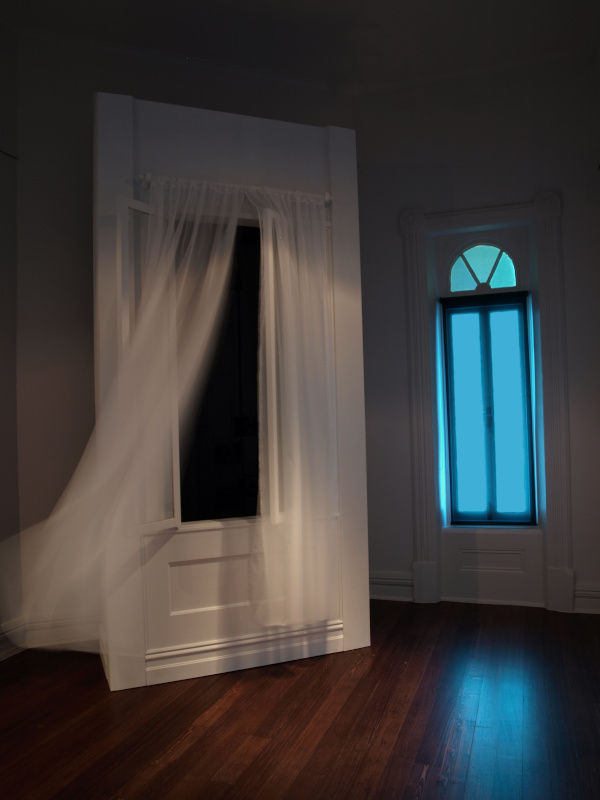
Night Window. In: Cloudy Sensoria. 2012. Malte Wagenfeld. Bundoora Homestead Gallery, Melbourne. Photo: Malte Wagenfeld.
Audio: sound of Night Window
Despite concerns that the perceptual tricks would be too apparent, they combined in a surprising way to create an immersive sensory ambiance. Entering the room there was an uncanny sense of dislocation, as if one had been shifted - ever so slightly - in time and space; the windows framed by gently billowing curtains, generated a momentary temporal and perceptual disorientation. Standing in front of the open window, the viewer perceived moist cool air laden with scents of hay and cut grass from the generated breeze, and sounds of gentle rainfall intermingled with nocturnal birds and the muffled neighing of horses from Livia Ruzic's evocative soundtrack.
The effect was subtle but palpable and most visitors lingered in the semi-darkness taking in the tranquil night-air, sometimes attempting to poke their heads through the window. Night Window's, gentle summer rainstorm is a familiar and shared phenomenological experience, triggering psychosomatic responses as personal memories merge with perceptual encounters.
The composed sounds proved critical to locating the work geographically and contextualising the time-memory-shift of the homestead, while signalling the outside weather event to connect the interior 'false' window to the imagined exterior. Each sonic texture linked with, and reinforced, other perceptual encounters - the nocturnal sounds of Australian native birds with the darkened room and deep blue light; the sound of horses with the scent of hay and cut grass; the stippled sound of rainfall with the sensation of cool air and billowing curtains.
3. - Dynamics of Air Exhibition
The following 5 phenomenological installations explored ways to design with atmospheric phenomena and ambiance. They were selected from 28 works exhibited in Dynamics of Air, an exhibition - which I curated with Jane Burry at RMIT Gallery in Melbourne, Australia (2018) - in which I also participated as an exhibiting artist.
Dynamics of Air was intended as a laboratory to investigate how artists, designers and researchers explore and work with air and atmosphere in a time of heightened awareness of human impact on the global climate. We were exploring the premise that a collective conceptual shift in thinking has occurred away from "the material, solid and fixed towards the immaterial, fluid, transient and temporal; from cerebral aesthetic judgement to phenomenological experience; from a desire for certainty to an embracing of complexity",8 and how these effect our relationship to air and climate.
Projects exhibited were commissioned and site-specific, so sensitivity to atmospherics in the six distinct gallery spaces was critical in allowing us "to curate the work thematically as an assemblage of experiences with different levels of sensory through to intellectual engagement."9
3.1 - addressable volume: Edith Kollath
Entering the gallery from the street, visitors were carried on recursive waves of 'noise' - a low metallic drone interspaced by pneumatic sounds of escaping air and elongated crystalline explosions - into the central gallery, where they were confronted by Berlin artist Edith Kollath's video montage addressable volume of glass bubbles being blown beyond the limits of material resilience.
This five-channel installation shows actors exhaling glass bubbles of air, becoming thinner as they expand, until so fragile that they explode, releasing their breath, which is passed to another. It explores notions of breath as a shared medium - from presence, warmth and intimacy to how air moves within us and between us.
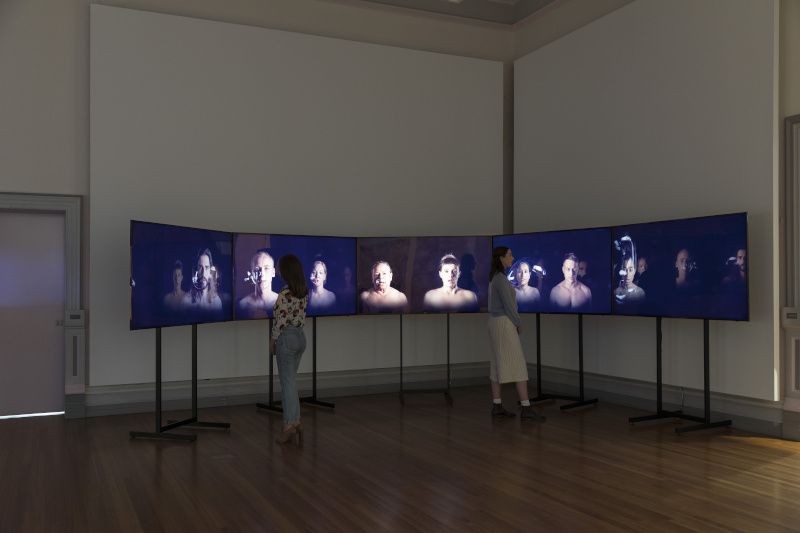
addressable volume. Edith Kollath. 2018. In: Dynamics of Air. RMIT Gallery, Melbourne. Photo: Mark Ashkanasy.
The soundtrack was to be heard through headphones, but when played over multiple speakers housed within the five screens we realised its potency as a pulsating sonic ambiance to underscore the entire exhibition. The communal experience of listening also aligned with the work's thematic of shared breath.
3.2 - nothing will ever be the same: Edith Kollath
Kollath's nothing will ever be the same, also sited in the central gallery, contributed a distinctively different mesmerising voice.
A translucent cloth is set in motion. Drifting from the ceiling then, lifted by an automatic mechanism, is released again. The action is repeated endlessly, rhythmic as breath - inhalation - pause - exhalation - pause. Buffered by invisible air currents the cloth floats, its soft folds ripple as if alive then, overcome by gravity, it falls, reshaping into a different thing and always landing in a different place. Visually the work has a weightless translucence. During its cyclic resurrection the faint whirr from electric motors can be detected. Its fall is signalled by a gusty whistle from the mechanism as cord is ripped from its spool, followed by quick taps as the metal balls sewn into the cloth's corners bounce upon landing.
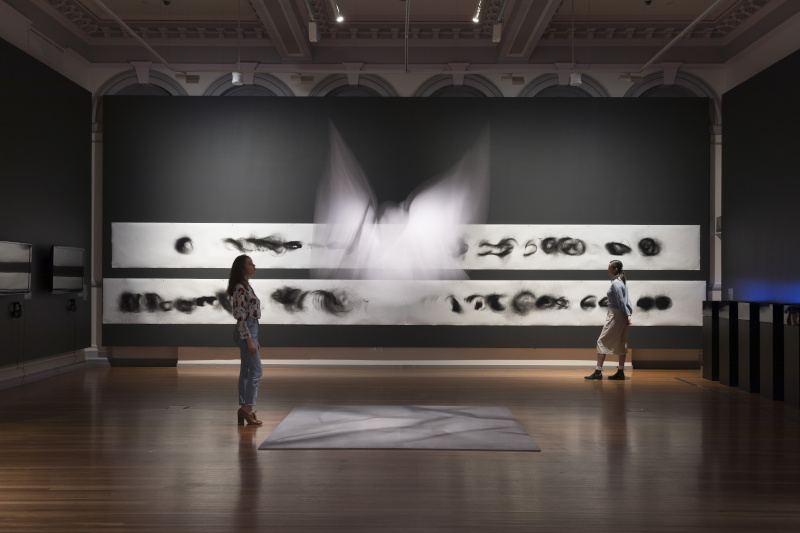
nothing will ever be the same. Edith Kollath. 2018. In: Dynamics of Air. RMIT Gallery, Melbourne. Photo: Mark Ashkanasy.
nothing will ever be the same. Edith Kollath. 2018. In: Dynamics of Air. RMIT Gallery, Melbourne. Video: Margund Sallowsky.
Like Atmospheric Structure, the soundtrack arose from the subtle poise of unintended mechanical kinetics and atmospheric unpredictability, emerging as a defining 'of the moment' sonic experience.
3.3 - Sounding the Air: Chris Cottrell
The sounds emanating from Kollath's works co-mingled with Chris Cottrell's Sounding the Air to create a haunting atmosphere that emerged as unscripted soundtrack, reminiscent of Brian Eno's 1999 composition 'I Dormenti', a 3-note looped drone of echoes interspersed with lyrical utterances and whispers.
In Cottrell's buoyant work, a helium-filled balloon traversed the airspace responding to the slightest changes in temperature, air pressure and currents, playing "an audio work of ambient recordings of air interspersed with different voices reading quotes related to thinking through air"10. The audio was delivered from a small FM transistor radio suspended from the balloon, hacked to tune into a transmitter housed in another part of the gallery.
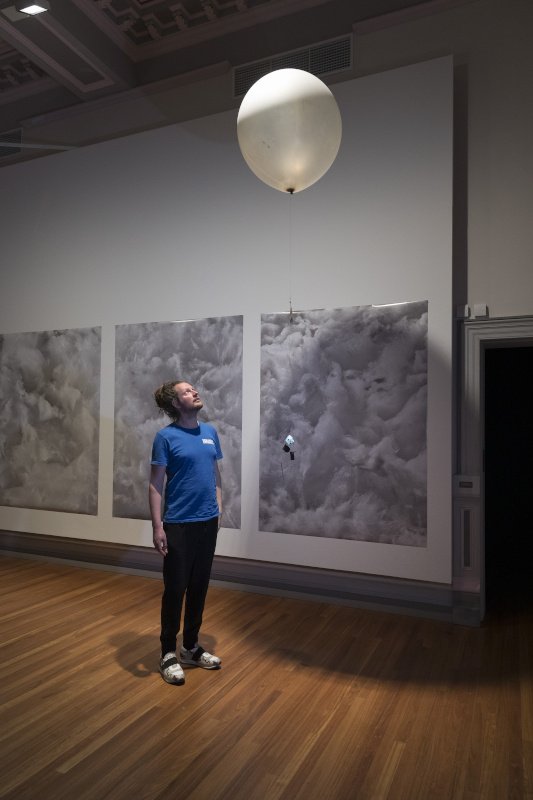
Sounding the Air. Chris Cottrell. 2018. In: Dynamics of Air. RMIT Gallery, Melbourne. Photo: Mark Ashkanasy.
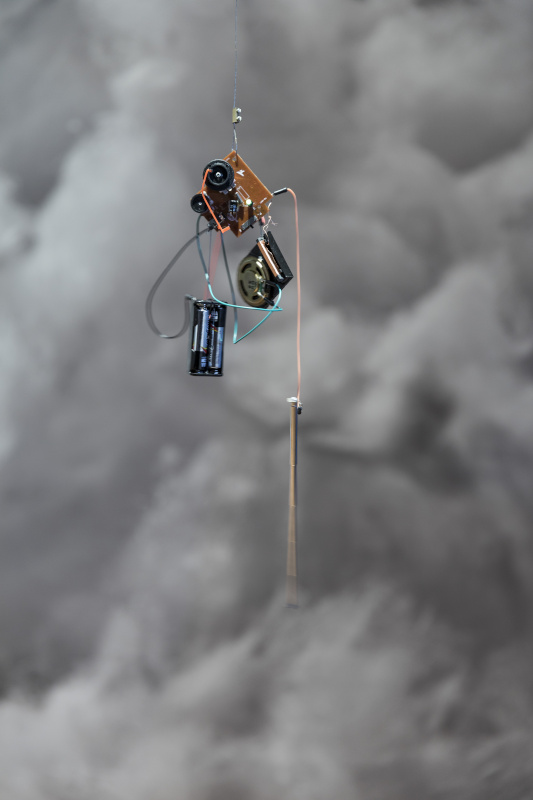
Sounding the Air: detail. Chris Cottrell. 2018. In: Dynamics of Air. RMIT Gallery, Melbourne. Photo: Mark Ashkanasy.
Sounding the Air. Chris Cottrell. 2018. In Dynamics of Air. RMIT Gallery, Melbourne. This is an excerpt of a 35m 20s audio collage. Sound: Chris Cottrell et al.
The sphere of sonic influence is small, a few meters in diameter, and reliant on maintaining a fine balance between shifting air patterns and atmospheric conditions. The encounter with Sounding the Air is casual and unconstrained. As one moves close enough to tune into the delicate aerial sounds and voices, ones very presence disrupts the balance, the work drifts, hooks onto a new current - floating away. Every now and again the receiver loses its signal and transmits a haze of pink noise before catching its homing frequency.
Unlike Eno's composition, the ambient score that defined Gallery 1 arose from a serendipitous mix of shifting atmospheric phenomena, rhythmic sounds produced by the installation's mechanical aspects and looping acoustic arrangement. But the emergent score also resulted from thoughtful discussion between artists and technicians - aware of the sound interplay between sited works, volume adjustments and the potential afforded by these acoustic possibilities.
3.4 - Aerosol: Breathe Earth Collective
Wandering into an adjacent gallery one inhales aromatic aerosols while hearing sounds reminiscent of falling rain that produce a feeling of atmospheric serenity, even before seeing the source of the sensory stimuli: a 4 by 4 metre high and wide structure of tightly bundled twigs dripping from overhead with saline water. The twigs vaporise the water droplets into fine mist, releasing their natural essential oils into the gallery as therapeutic aerosols.
Aerosol was devised by the Austrian Breathe Earth Collective - Lisa Maria Enzenhofer, Markus Jeschaunig and Bernhard König - as a reinterpretation of the traditional vernacular of 'Gradierwerke' or 'graduation towers', from regions around Germany and Austria. Originally built, from around the 16th century, to harvest salt by pumping saline spring water over a wall of bundled twigs, which splinters and partly evaporates, resulting in a higher saline concentration at the bottom. When the restorative benefits of breathing the salty air were realised these giant evaporative coolers were repurposed as health spas.
Breathe Earth Collective reimagined how such structures could be utilised in public spaces for communal benefit. To localise the work, they used materials indigenous to Australia. Sophia Pearce, a First Nations Barkandji woman, recommended native Melaleuca shrub used by her people for cleansing ceremonies. Salt was harvested from Pink Lakes and Murray River aquifers inland from Melbourne.
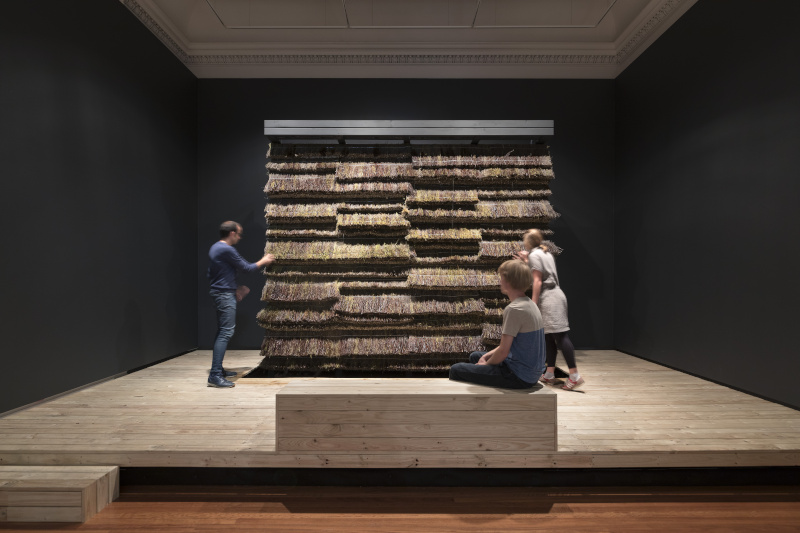
Aerosol. Breathe Earth Collective. 2018. In: Dynamics of Air. RMIT Gallery, Melbourne. Photo: Mark Ashkanasy.
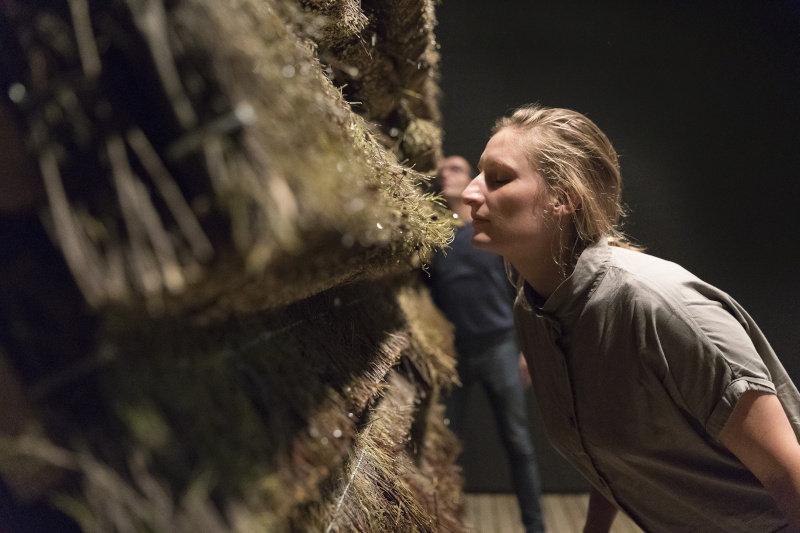
Aerosol: detail. Breathe Earth Collective. 2018. In: Dynamics of Air. RMIT Gallery, Melbourne. Photo: Mark Ashkanasy.
Aerosol. Breathe Earth Collective. 2018. In: Dynamics of Air. RMIT Gallery, Melbourne. Video: Margund Sallowsky.
Set against black walls in subdued light to highlight the curtain of falling water, the inherent atmospheric sounds of Aerosol were carefully considered in how they would sculpt the desired ambiance - soft rain dripping from branches, punctuated by short gushes, as water is pumped into the overhead reservoir, pooling over a timber platform into a shallow basin of saline water. Visitors could sit awhile breathing in the cool salty air, feeling small sprays of water mist on their skin and immersing in the revitalising ambiance of this rich, sensory environment.
3.5 - Outside_In: Malte Wagenfeld and Thomas Auer
In addition to my role as curator, I was also an exhibiting artist in the Dynamics of Air exhibition. Outside_In, a collaboration between myself and Thomas Auer from climate engineering company Transsolar, explored how to translate climatic experiences encountered in an outside environment - such as breezes, dappled shade and radiant sunlight, pockets of warm and cool air - into an interior space: to bring the outside in.
Entering the gallery space, the visitor encounters a large geometric structure, placed near the centre, slightly askew, consisting of two parabolic concave surfaces back-to-back at a 34-degree incline defining two distinctly different microclimates. One side, cave-like, simulating the cool, dark, moist air of a forest gorge; the other dry and bright, conjuring a beach dune baking in the radiant warmth of the sun. On either end, the walls reflect a specially calibrated light, the iridescent green of a forest canopy and the deep blue of the ocean sky.
The juxtaposition of two contrasting microclimatic experiences enabled us to investigate how they morphed at the edges, and how each impacted on the other. Visitors moving from the cool cave to hot beach reported subtle sensory shifts in atmosphere and perceptual environments, which revealed a spectrum of dynamic microclimatic bodily encounters.
This porous interplay is amplified by our psychosomatic experience; where the ‘soma’ is the bodily receiving of the generated atmosphere, and the ‘psycho’ the translated perceptual ambiance. Being immersed in experiential phenomena of this installation - the cool mist, radiant heat, the iridescent green and cerulean blue - is essentially a bodily experience, but together these elicit other more abstract and more intimate phenomena, coloured by past experiences, that act on the corporeal level. As Böhme puts it "One does not quite know where they are. They seem to fill the space with a Gehfühlston (feeling-tone), like a haze."11
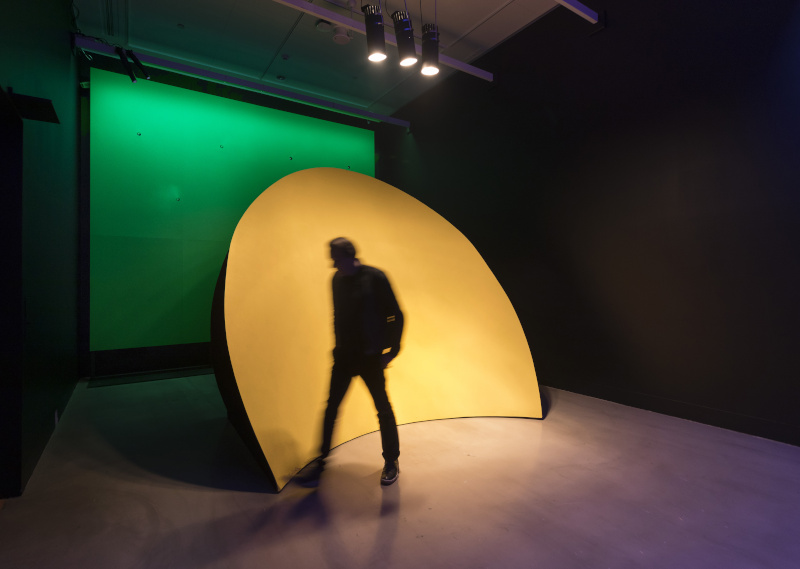
Outside_In: beach side. Malte Wagenfeld and Thomas Auer. 2018. In: Dynamics of Air. RMIT Gallery, Melbourne. Photo: Mark Ashkanasy.
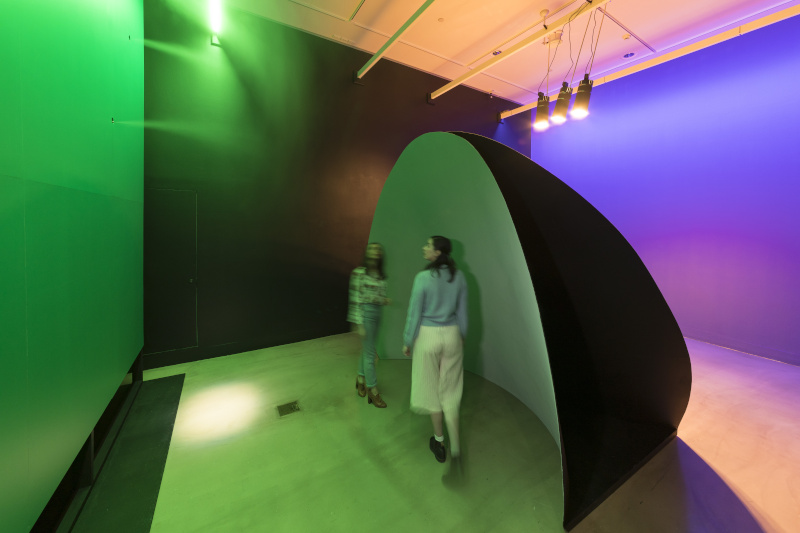
Outside_In: forest side. Malte Wagenfeld and Thomas Auer. 2018. In: Dynamics of Air. RMIT Gallery, Melbourne. Photo: Mark Ashkanasy.
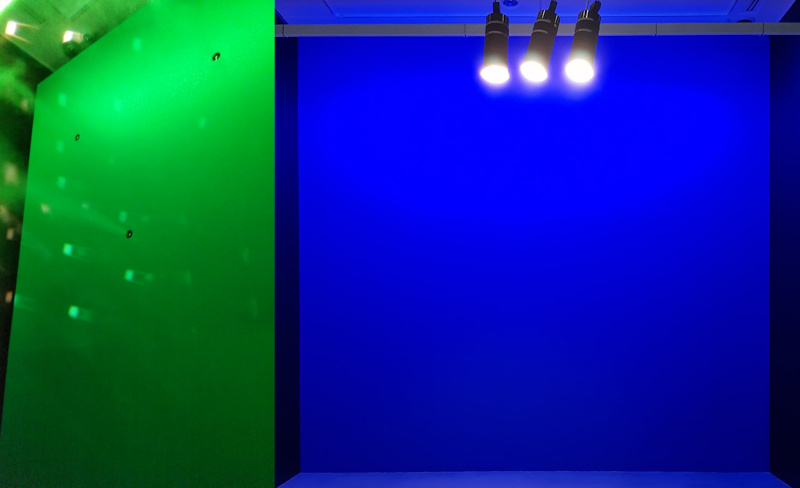
Outside_In: blue green. Malte Wagenfeld and Thomas Auer. 2018. In: Dynamics of Air. RMIT Gallery, Melbourne. Photo: Malte Wagenfeld.
Outside_In. Malte Wagenfeld and Thomas Auer. 2018. In: Dynamics of Air. RMIT Gallery, Melbourne. Video: Margund Sallowsky.
Devised soundscapes were considered in early design probes, which began as a complex matrix of microclimatic experiences and ended as the playful duality of a German forest and Australian beach. The simplicity of this concept resonated with discoveries from previous installations, such as Night Window, where manipulating a few phenomena generated a perceptually dynamic environment. Unlike Night Window, ideas of inserting a synthesised soundscape were abandoned as I attuned to the heighted sonic experience already being generated from the installation itself.
In sculpting the soundscape, an understanding of the phenomenological possibilities of the parabolic structure was instrumental. The forest air was produced by high-pressure water pumped through jets with a micro-aperture to generate fine, dry mist. The gentle hiss of these misters dissolved into pink noise, resembling a distant waterfall resonating inside the dish, adding to the perception of being deep inside a forest with the muffled and muted sounds of the gallery beyond; walking around the structure into the sun, the sounds, reflecting off the dish, felt much brighter, heightening the pleasure of standing on a beach.
Utilising immaterial atmospheric phenomena in this way, requires a 'knowhow' of how they interact with and are fashioned by the physical world. In a forest gorge, the moist air is shaped and cooled as it is caught between lush tree canopies and stone face radiating cold; sunlight is filtered and refracted as are sounds; and moist air alters our perception of sound. On one side the beach dune reflects sounds of crashing waves and the sun's light, its thermal mass radiates warmth, whist protecting from the other. These material manifestations modulate atmospheric - including sonic - phenomena and also act on and alter our perception of them.
4 - Conclusions
The attendant sonic ambiances of the installations considered, reveal a mix of devised and unscripted soundscapes. For each, an understanding of how atmospheric phenomena interplay to shape sound and how sound interplays with and between experience and memory, became essential in design and siting decisions.
From the works analysed, I identify a typology of four conditions responsible for producing the specific qualities of the attendant soundscapes:
- Atmospheric phenomena interacting with the material world, for example the sound of the mist reverberating within the parabolic dish; examples from nature include the sound of breezes rustling leaves or the patter of rain on a surface.
- Sonic events from one atmosphere entering another that highlights the porosity of atmospheres, causing different atmospheres to meld into or interrupt each other. For instance: John Cage's traffic entering through the window. Curiously, we can be perceptually present in more then one atmosphere simultaneously, our body being immersed in one whilst hearing, seeing or smelling layers of another.
- Kinematic 'machinery' for producing atmosphere, such as the misters and the vortex machine; and in daily life we might hear the sound of ventilators and air-conditioners.
- Anthropogenic, synthesised soundtracks intended as part of the atmospheric experience, as in Night Window. Ambient 'atmospheric' music, such as that of Brian Eno and Éliane Radigue, fall within this category; composed to meld with the atmosphere, to elicit a certain ambiance or become the atmosphere.
In this context, the potential of harnessing ambient soundscapes - devised or arising from a confluence of kinematic and phenomenological forces generated by the mechanics, spatial interplay and geometries of a particular installation - has emerged as a significant part of my design process. After more then a decade of 'wrangling' phenomena to design atmospheres I have become sensitised to the nuanced layers upon which they float, to the perceptual interplay within atmospheres, and to the feeling of ambiances; in particular, the role that sound plays in building an immersive atmosphere. Having listened back to these installations, I have become much more attuned to the activity of sound, even in seemingly silent works.
Sonic sensations emerge from or with other phenomena. As a designer of air, recognising the possibilities of arranging settings to enable them to freely present and transpire mostly requires the practice of attuned perceiving, modulating and adjusting the levers of the phenomenological machinery - and knowing when to leave things just as they are.
Footnotes
- Bidou, Jacques. 1992. Ecoute. Documentary Film. Directed By Miroslav Sebestik. France. JBA-Production, La Sept, Centre Georges Pompidou. ↩
- Böhme, Gernot. 1998. "Atmosphere as an Aesthetic Concept." Daidalos: Constructing Atmospheres 68. 114. ↩
- Böhme, Gernot. 2017. Atmospheric Architectures: The Aesthetics of Felt Spaces. London: Bloomsbury. ↩
- Thibaud, Jean-Paul. 2015. "The backstage of urban ambiances: When atmospheres pervade everyday experience". Emotion, Space and Society 15. 41. ↩
- Thibaud, Jean-Paul. 2015. "The backstage of urban ambiances: When atmospheres pervade everyday experience". Emotion, Space and Society 15. 40. ↩
- Griffero, Tonino. 2017. Quasi-Things: The Paradigm of Atmospheres. New York: Sunny Press, State University of New York. ↩
- Thibaud, Jean-Paul. 2015. "The backstage of urban ambiance: When atmospheres pervade everyday experience". Emotion, Space and Society 15. 41. ↩
- Wagenfeld, Malte, Jane Burry. 2019. Dynamics of Air. Exhibition Catalogue. Melbourne: RMIT Gallery. 14 ↩
- Ibid. 15 ↩
- Ibid. 52 ↩
- Böhme, Gernot. 2017. Atmospheric Architectures: The Aesthetics of Felt Spaces. London: Bloomsbury. 14. ↩

